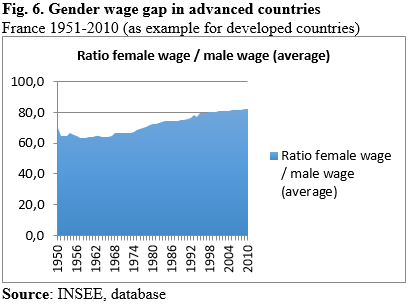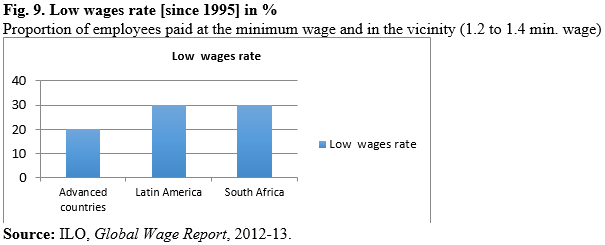2. Wage dispersion and inequalities
→ Download the presentation paper
Reminder:
- Dispersion: arithmetic distribution of values relative to the average
- Disparity: distribution deemed disproportionate by a given society
In all countries, there are large differences between individuals, usually related to differences in qualifications, age, gender, firm size or sector. Depending on the case, a greater or a lesser part of these differences constitutes true inequalities of treatment in relation to the work carried out
1. Dispersion, disparities, inequalities
In seeking to qualify the “dispersion” of wages (disparities / inequalities / injustice), the WAGE network could endeavour to examine in particular the gender wage gap, low wages persistence, the (wage) Gini index, etc.
For example, Europe is today divided into four or five different development levels or subgroups. In the early years of this decade, the EU's annual gross salary hovered around €30.000. However it reached €40.000 to €50.000 in countries with higher living standards (i.e. Denmark, Finland, Luxembourg, Belgium), higher than the bigger economies like France, the UK (€34.000) or Germany (€38.000) while Italy remains at the average. Countries with the lowest standard of wages hover around €5.000 to €10.000 (i.e. Bulgaria, Romania, Lithuania, Slovakia, Hungary). When adjusted for PPP, expressed in dollars, we still find a significant gap between 1 to 3 and 1 to 2.5 (OECD 2012).
In this example, the network could aim to examine the role of labour costs in exports and the attractiveness of wages in advanced countries for potential migrants. The gap (PPP) between Europe e.g. and the major emerging countries is 1 to 3, with developing countries from 1 to 7.5, and the LDCs from 1 to 25
Salaries of youth could be one of the prime targets in the analysis of inequalities, because it captures many elements. It is a major concern for advanced countries and also for emerging countries’ leaders or public policies. Salaries of the young raise the issue of youth employability, and also involves the training system and therefore education or University efficiency. All this chain leads to the issue of decent work, in accordance with the efforts of the ILO.
2. Gender wage gap
The gender wage gap is an important concern in the global economy and could be an interesting approach to this debate between dispersion and inequality.
Currently, the monthly gender wage gap is about 45% in Azerbaijan, 42% in Georgia, 40% in Tajikistan, 39% in Russia, 34% in Israel, but 25% in Canada, around 20 % in Germany, about 18% in the USA and 15% in Poland.
In India, in the formal sector, the gap is currently 25%, but it was 45% in the 1990s; it varies considerably from one Indian state to another, and according to age and qualification. But this refers to the formal sector: women still work predominantly in the informal sector and in rural areas, where wage differentials of 30 to 50% with men are possible.

In emerging and developing countries, the gender gap is higher, between 40 and 50%, because women are less qualified, occupy most rural employment and are in the informal economy. With economic and social acceleration, the job structure moves to industry, cities, services and technologies; the gap may increase if the qualification of women changes a little or conversely decrease if the qualification of women follows the general development. The narrowing of the gap can function as a social development index for the country.
However, we have to pay attention to bias, especially to qualification gaps. It can be seen from Figure 12 that, in 1995, the proportion of men and women employed as middle-level staff is equivalent. Then, the over-representation of women among employees is compensated by that of the men among the workers. In senior management positions, however, there are twice as many men as women. The average male wage is partly increased by this qualification gap in employment in top positions.

3. The diversity of the statistical dispersion criteria [and of potential wage inequalities]
Several criteria make it possible to apprehend the dispersion of wages and then, under conditions, to qualify this as inequality: the inter-decile gap D9 / D1, which is higher in the USA than in Europe within the advanced countries and more important in the emerging countries than in the advanced countries (Figure 8).

Another interesting criterion is the rate of low wages in the vicinity of the minimum wage (up to 1.4 times the minimum wage); emerging countries offer again greater variances (Figure 13).

. Building a Gini index of wages could be an objective for the WAGE network.
. Less studied are wage gaps between intellectual and physical labour, engineers and workers, knowledge-intensive industries and more traditional industries. Such wage gaps are widening if we test dynamic data for different countries for the period 1960-2010. We could compare those gaps with time series for different countries.
. On the other hand, we could compare wage indices for knowledge-intensive industries of different countries to test the hypothesis of those wages convergence. We could expect that for most of countries, we'll see convergence process.
. In these cases, (gender, D9 / D1, low wages, Gini index), emerging countries have larger internal gaps linked to faster economic growth, which accelerates the rise in incomes upward, faster than at the bottom of the pay scale. The wage grid opens upwards, most likely for a time, according to the intuition of the Kuznets curve[1], even taking in consideration the critics on the curve, for example by Thomas Piketty[2].
[1] S. Kuznets, 1955, “Economic Growth and Income Inequality”, American Economic Review, Vol. N°45, p.1-28
[2] T. Piketty, “The Kuznets' curve, yesterday and tomorrow”, in Banerjee, A, Benabou, R, Mookerhee, D, (Ed), Understanding poverty, Oxford, Oxford University Press, 2005. The reduction of inequalities is not mechanically associated with per capita GDP growth. Historically, it seems be mainly linked to unexpected events affecting capital (war, inflation) and by taxation (specially income tax).
